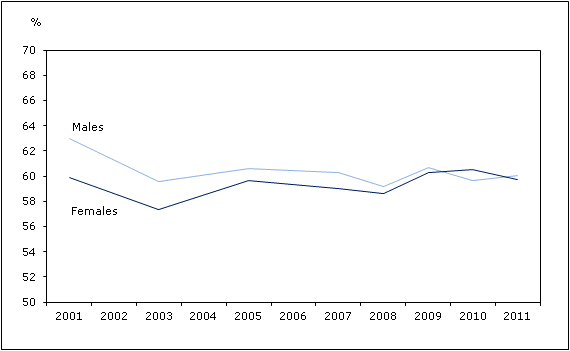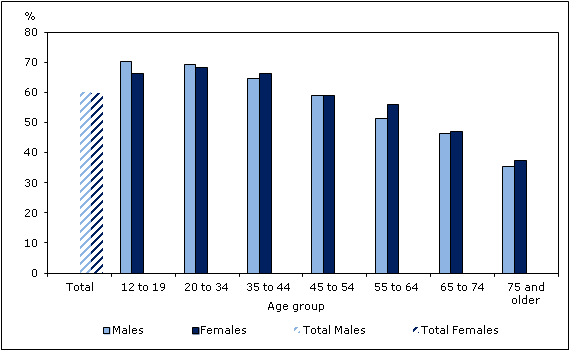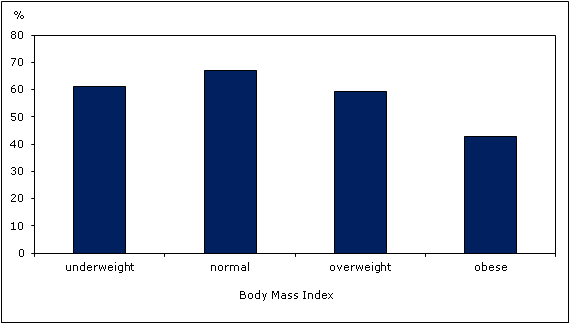Perceived health, 2011
Archived Content
Information identified as archived is provided for reference, research or recordkeeping purposes. It is not subject to the Government of Canada Web Standards and has not been altered or updated since it was archived. Please "contact us" to request a format other than those available.

Perceived health is an indicator of overall health status. It can reflect aspects of health not captured in other measures, such as incipient disease, disease severity, physiological and psychological reserves as well as social and mental function. Perceived health refers to a person's health in general — not only the absence of disease or injury, but also physical, mental and social well-being.
In 2011, 59.9% of Canadians aged 12 and older assessed their health as 'very good' or 'excellent,' unchanged since 2009.
From 2001 to 2007 males were more likely than females to report very good or excellent health, but from 2008 to 2011 there has been no overall difference between the sexes (Chart 1).
Chart 1
Percentage reporting very good or excellent health, by sex, household population aged 12 or older, Canada, 2001 to 2011

Source: Canadian Community Health Survey, 2001, 2003, 2005, 2007, 2008, 2009, 2010, 2011.
Very good or excellent health decreased with each age group starting from 35 years of age. Females had a higher rate of perceived health than males at the 55 to 64 age group but a lower rate of perceived health at the 12 to 19 age group. At other ages there was no significant difference between the sexes (Chart 2).
Chart 2
Percentage reporting very good or excellent health, household population aged 12 or older, by age group and sex, Canada, 2011

Source: Canadian Community Health Survey, 2011.
Body weight is also important to perceived health. Among those of normal weight—based on respondent-reported height and Health Canada guidelines on body mass index— 66.9% were in very good or excellent health, compared with 61.1% of underweight Canadians, 59.4% of overweight Canadians and 42.7% of obese Canadians (Chart 3).
Research has shown that people who feel a sense of belonging to a local community tend to enjoy better physical and mental health1. In 2011, 64.1% of people who reported a very strong or somewhat strong sense of belonging to their local community also reported very good or excellent health, compared with 54.4% of those who felt weaker ties to their local community.
Chart 3
Percentage with very good to excellent health, household population aged 12 or older, by body mass index, Canada, 2011

Source: Canadian Community Health Survey, 2011.
The proportion of residents who reported they were in very good or excellent health was lower than the national average in five jurisdictions: New Brunswick (53.9%), Manitoba (56.7%), Saskatchewan (56.9%), Northwest Territories (49.8%) and Nunavut (40.6%). The proportion of residents who reported they were in very good or excellent health was higher than the national average only in Alberta (62.0%). Residents of the other provinces and territories reported very good or excellent health at approximately the national average rate.
Because of the strong relationship between age and perceived health, provinces and territories with disproportionately younger populations are expected to have perceived health rates above the national average. The reverse is true for provinces and territories with older populations. To remove the effect of different age distributions, the rates of very good or excellent perceived health were recalculated as if the age groups in each province and territory were the same as at the national level. Based on these age-standardizing calculations, New Brunswick, Manitoba, Saskatchewan, Northwest Territories and Nunavut remained below the national average. There were no provinces or territories that were significantly higher than the national average. Residents of Alberta, Newfoundland and Labrador, Prince Edward Island, Nova Scotia, Quebec, Ontario, British Columbia, and Yukon reported very good or excellent health at rates that were about the same as the rate for Canada as a whole.
Endnote
- Ross, Nancy. 2002. "Community Belonging and Health." Health Reports. Vol. 13, no. 3. Statistics Canada Catalogue no. 82-003. page 35. /studies-etudes/82-003/archive/2002/6105-eng.pdf (accessed May 10, 2010).
References
Ross, Nancy. 2002. "Community Belonging and Health." Health Reports. Vol. 13, no. 3. Statistics Canada Catalogue no. 82-003. page 35. /studies-etudes/82-003/archive/2002/6105-eng.pdf (accessed May 10, 2010).
Data
Additional data from the Canadian Community Health Survey are available from CANSIM table 105–0501.
- Date modified:
